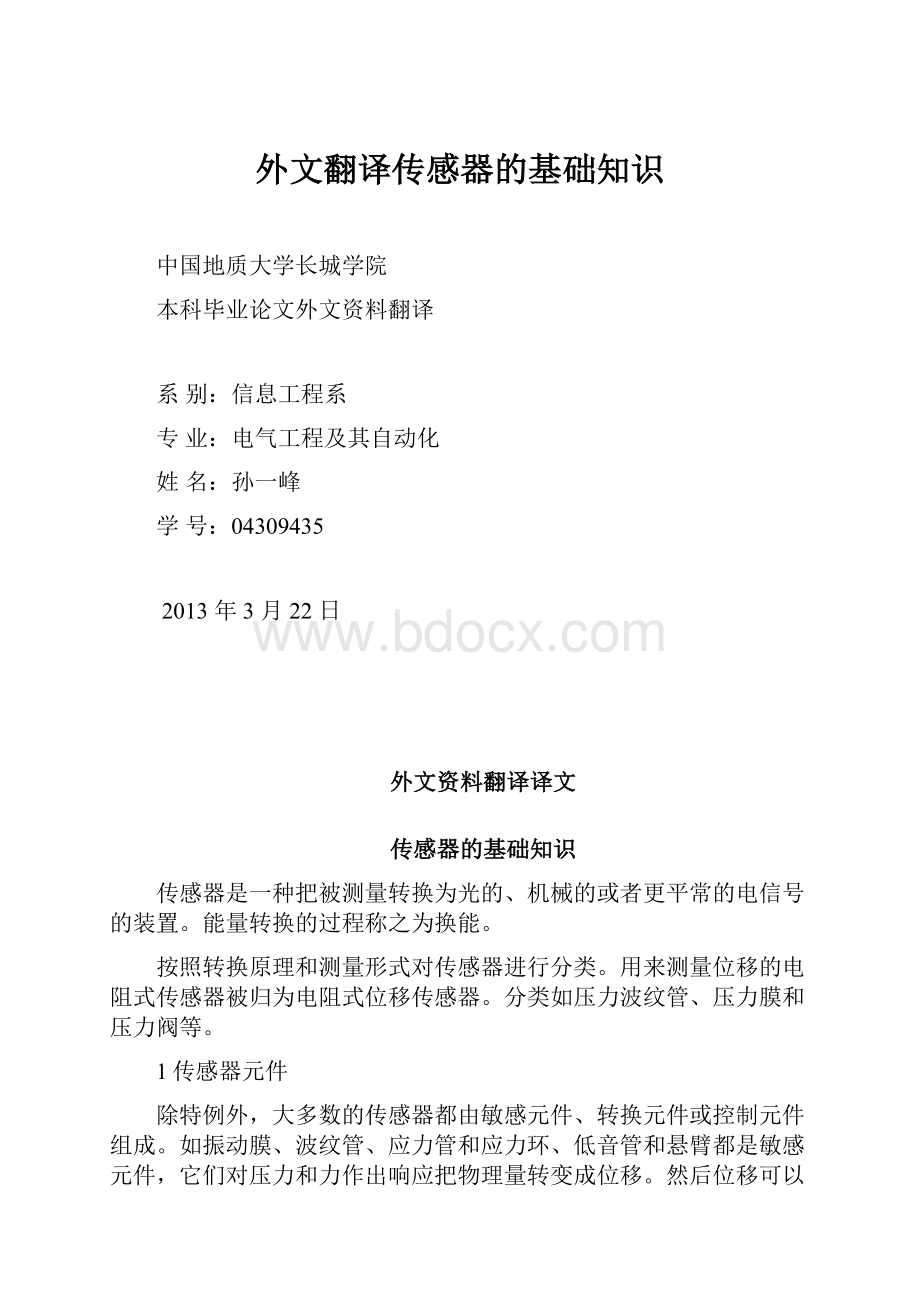 外文翻译传感器的基础知识.docx
外文翻译传感器的基础知识.docx
- 文档编号:9638948
- 上传时间:2023-02-05
- 格式:DOCX
- 页数:13
- 大小:22.86KB
外文翻译传感器的基础知识.docx
《外文翻译传感器的基础知识.docx》由会员分享,可在线阅读,更多相关《外文翻译传感器的基础知识.docx(13页珍藏版)》请在冰豆网上搜索。

外文翻译传感器的基础知识
中国地质大学长城学院
本科毕业论文外文资料翻译
系别:
信息工程系
专业:
电气工程及其自动化
姓名:
孙一峰
学号:
04309435
2013年3月22日
外文资料翻译译文
传感器的基础知识
传感器是一种把被测量转换为光的、机械的或者更平常的电信号的装置。
能量转换的过程称之为换能。
按照转换原理和测量形式对传感器进行分类。
用来测量位移的电阻式传感器被归为电阻式位移传感器。
分类如压力波纹管、压力膜和压力阀等。
1传感器元件
除特例外,大多数的传感器都由敏感元件、转换元件或控制元件组成。
如振动膜、波纹管、应力管和应力环、低音管和悬臂都是敏感元件,它们对压力和力作出响应把物理量转变成位移。
然后位移可以改变电参数,如电压、电阻、电容或者感应系数。
机械式和电子式元件合并形成机电式传感设备或传感器。
这样的组合可用来输入能量信号。
热的,光的,磁的和化学的相互结合产生的热电式、光电式、电磁式和电化学式传感器。
2传感器灵敏度
通过校正测量系统获得的被测物理量和传感器输出信号的关系叫做传感器灵敏度K1,也就是K1=输出信号增量/测量增量。
实际中,传感器的灵敏度是已知的,并且通过测量输出信号,输入量由下式决定,输入量=输出信号增量/K1。
3理想传感器的特性
(1)高保真性:
传感器输出波形应该真实可靠地再现被测量,并且失真很小。
(2)可测量最小的干扰,任何时候传感器的出现不能改变被测量。
(3)尺寸:
传感器必须能正确地放在所需的地方。
(4)被测量和传感器信号之间应该有一个线性关系。
(5)传感器对外部影响的灵敏度应该小,例如压力传感器经常受到外部振动和温度的
响。
(6)传感器的固有频率应该避开被测量的频率和谐波。
4电传感器
电传感器具有许多理想特性。
它们不仅实现远程测量和显示,还能提供高灵敏度。
电传感器可分为两大类。
4.1变参数型
(1)电阻式;
(2)电容式;
(3)自感应式;
(4)互感应式;
这些传感器的工作依靠外部电压。
4.2自激型
(1)电磁式;
(2)热电式;
(3)光栅式;
(4)压电式;
这些传感器根据测量输入值产生输出电压,而且这一过程是可逆的。
比如,在一般情况下,压电式传感器可根据晶体材料的变形产生一个输出电压;但是,如果在材料上施加一个可变电压,传感器可以通过变形或与变电压同频率的振动来体现可逆效应。
5电阻式传感器
电阻式传感器可以分为两大类:
(1)那些表现为大电阻变化的物理量可通过分压方式进行测量,电位器就属于此类。
(2)那些表现为小电阻变化的物理量可通过桥电路方式进行测量,这一类包括应变仪和电阻温度计。
5.1电位器
绕线式电位器由许多绕在非导体骨架的电阻丝以及滑行在线圈上的触头组成。
结构原理如图,触头能够转动、直线式运动或者两运动合成的螺旋式运动。
如果测量设备的电阻比电位器的电阻大,那么电压既可以是交流也可以是直流,且输出电压与输入运动成正比。
这样的电位器存在着分辨率和电子噪声的问题。
分辨率是指传感器能检测到的最小的输入增量,分辨率大小取决于线圈与滑动触头围成的面积。
因此,输出电压为触头从一端移到另一端时一系列阶跃。
电子噪声可以通过接触电阻的振动、触头摩擦形成的机械磨损以及从敏感元件传出的触头振动产生。
另外,测得的运动量可以通过惯性和电位器中移动元件的摩擦获得较大的机械载荷。
触头表面的磨损将电位器的寿命限制为多少转。
通常指的是生产商在说明书中提及的“寿命转数”,一个典型值为20*1000000转。
空载电位器电路的输出电压V0由下式决定:
设电阻R1=xi/xt*Rt,其中xi为输入位移,xt为最大可能位移,Rt为电位器的电阻。
那么输入电压V0=V*R1/(R1+(Rt-R1))=V*R1/Rt=V*xi/xt*Rt/Rt=V*xi/xt上式表明,对于空载电位器输出电压和输入位移呈直线关系。
通过提高激励电压V可以获得高的灵敏度。
但是,V的最大值由电位器线圈金属丝的功率损耗P决定,即V=(PRt)1/2。
5.2电阻应变仪
电阻应变仪是由机械应变产生电阻变化的传感器。
它们可以是耦合的或者非耦合的
5.2.1耦合应变仪
运用黏合剂可将应变仪与被检测的结构或部件的表面粘合或粘牢。
耦合应变仪分为:
(1)粘合在绝缘纸背后的金属细丝仪
(2)在环氧树脂上粘贴导电箔片的光栅
(3)在环氧树脂上粘贴铜或镍的半导体丝
电阻应变仪可作为单个元件仅在一个方向测量应力,或者几个元件的组合体可在几个方向同时进行测量。
5.2.2非耦合应变仪
一典型应变仪表明细电阻丝在悬臂弹簧偏差作用下改变电阻丝张力进而改变电阻丝的阻值。
商业上通常在力、负载、压力传感器上运用此方法。
5.3电阻温度传感器
此传感器的材料有以下两大类
(1)金属(如铂、铜、钨、镍)的阻值会随着温度的升高而增大,即有一个正温度电阻系数。
(2)半导体,如用锰、钴、铬或镍的氧化物制成的电热调节器,其阻值变化与温度变化存在一个非线性关系,即通常有一个负温度电阻系数。
5.3.1金属电阻温度传感器
在窄温度变化范围内,此类传感器取决于以下关系:
R1=R0[1+a(b1-b0)]
式中,a阻抗系数,R0为b0=0°时C的电阻
5.3.2电热调节器(半导体)电阻温度传感器
电热调节器为感温电阻器,其阻值变化与温度变化呈非线性关系。
通常此类传感器有一负温度系数。
对于小的温度增量,阻值的变化大体呈线性,但是如果存在大的温差,测量电路需运用特定线性化技术生成电阻随温度变化的线性关系。
电热调节器通常被制成附有玻璃质釉的半导体圆盘形状。
由于电热调节器可以小到1mn,所以响应的时间非常快。
5.4光敏元件
光敏元件采用光敏半导体材料做成。
当照射在半导体上的光强度增大,金属电极间的阻抗就会降低。
光敏元件常用的半导体材料有硫化镉、硫化铅和铜锗化合物。
频率的有效范围由所用材料决定。
硫化镉主要适用于可见光,硫化铅在红外线区有峰值响应,所以最适合于光故障检测以及温度测量。
5.5放射性光元件
当光照射到放射性光元件的阴极时,电子就会获取足够能量到达阴极。
阴极就会吸收这些电子产生一个通过电阻R的电流,从而形成一输出电压V。
产生的光电压V=I.R式中,I为光发射电流,I=K.B且为灵敏度,B输入照度(lm)
尽管输出电压能够表示照明的强度,这类元件却更多的应用于计算或调节,这里照射到阴极的光可被中断。
6电容式传感器
电容量随着相对介电常数、截面面积、或者极板间的距离的变化而变化。
电容的特征曲线表明,在空间的一段范围内,截面面积和相对介电常数的变化与电容量变化成线性关系。
不象电位器,变极距型电容传感器有无限的分辨率,这最适合测量微小的位移增量的位移。
7电感式传感器
电感可以通过改变电感电路的阻抗来调节。
电容式和电感式传感器的测量技术:
(1)用差分式电容或电感作为交流电桥。
(2)用交流电位计电路做动态测量。
(3)用直流电路为电容器提供正比于容值变化的电压。
(4)采用调频法,C或者L随着振荡电路频率的变化而改变。
电容式和电感式传感器的一些重要特性如下:
(1)分辨率无限。
(2)精确到满量程的+-0.1%。
(3)位移范围从25*10-6m到10-3m。
(4)上升时间小于50us
典型的被测量是位移、压力、振动量、声音和液位。
8线性调压器9压电式传感器10电磁式传感器11热电式传感器12光电管
13机械式传感器及敏感元件
外文原文
Basicknowledgeoftransducers
Atransducerisadevicewhichconvertsthequantitybeingmeasuredintoanoptical,mechanical,or-morecommonly-electricalsignal. Theenergy-conversionprocessthattakesplaceisreferredtoastransduction.
Transducersareclassifiedaccordingtothetransductionprincipleinvolvedandtheformofthemeasured.Thusaresistancetransducerformeasuringdisplacementisclassifiedasaresistancedisplacementtransducer.Otherclassificationexamplesarepressurebellows,forcediaphragm,pressureflapper-nozzle,andsoon.
1、TransducerElements
Althoughthereareexception,mosttransducersconsistofasensingelementandaconversionorcontrolelement.Forexample,diaphragms,bellows,straintubesandrings,bourdontubes,andcantileversaresensingelementswhichrespondtochangesinpressureorforceandconvertthesephysicalquantitiesintoadisplacement.Thisdisplacementmaythenbeusedtochangeanelectricalparametersuchasvoltage,resistance,capacitance,orinductance.Suchcombinationofmechanicalandelectricalelementsformelectromechanicaltransducingdevicesortransducers.Similarcombinationcanbemadeforotherenergyinputsuchasthermal.Photo,magneticandchemical,givingthermoelectric,photoelectric,electromaanetic,andelectrochemicaltransducersrespectively.
2、TransducerSensitivity
TherelationshipbetweenthemeasuredandthetransduceroutputsignalisusuallyobtainedbycalibrationtestsandisreferredtoasthetransducersensitivityK1=output-signalincrement/measuredincrement.Inpractice,thetransducersensitivityisusuallyknown,and,bymeasuringtheoutputsignal,theinputquantityisdeterminedfrominput=output-signalincrement/K1.
3、CharacteristicsofanIdealTransducer
Thehightransducershouldexhibitthefollowingcharacteristics
(1)highfidelity-thetransduceroutputwaveformshapebeafaithfulreproductionofthemeasured;thereshouldbeminimumdistortion.
(2)Thereshouldbeminimuminterferencewiththequantitybeingmeasured;thepresenceofthetransducershouldnotalterthemeasuredinanyway.
(3) Size.Thetransducermustbecapableofbeingplacedexactlywhereitisneeded.
(4)Thereshouldbealinearrelationshipbetweenthemeasuredandthetransducersignal.
(5)Thetransducershouldhaveminimumsensitivitytoexternaleffects,pressuretransducers,forexample,areoftensubjectedtoexternaleffectssuchvibrationandtemperature.
(6) Thenaturalfrequencyofthetransducershouldbewellseparatedfromthefrequencyandharmonicsofthemeasurand.
4、ElectricalTransducers
Electricaltransducersexhibitmanyoftheidealcharacteristics.Inadditiontheyofferhighsensitivityaswellaspromotingthepossibleofremoteindicationormesdurement.
Electricaltransducerscanbedividedintotwodistinctgroups:
4.1variable-control-parametertypes,whichinclude:
(1)Resistance
(2)Capacitance
(3)Inductance
(4)mutual-inductancetypes
Thesetransducersallrelyonexternalexcitationvoltagefortheiroperation.
4.2self-generatingtypes,whichinclude
(1) Electromagnetic
(2)Thermoelectric
(3)Photoemissive
(4)piezo-electrictypes
Theseallthemselvesproduceanoutputvoltageinresponsetothemeasurandinputandtheireffectsarereversible.Forexample,apiezo-electrictransducernormallyproducesanoutputvoltageinresponsetothedeformationofacrystallinematerial;however,ifanalternatingvoltageisappliedacrossthematerial,thetransducerexhibitsthereversibleeffectbydeformingorvibratingatthefrequencyofthealternatingvoltage.
5、ResistanceTransducers
Resistancetransducersmaybedividedintotwogroups,asfollows:
(1)Thosewhichexperiencealargeresistancechange,measuredbyusingpotential-dividermethods.Potentiometersareinthisgroup.
(2)Thosewhichexperienceasmallresistancechange,measuredbybridge-circuitmethods.Examplesofthisgroupincludestraingaugesandresistancethermometers.
5.1Potentiometers
Alinearwire-woundpotentiometerconsistsofanumberofturnsresistancewirewoundaroundanon-conductingformer,togetherwithawipingcontactwhichtravelsoverthebarwires.Theconstructionprinciplesareshowninfigurewhichindicatethatthewiperdisplacementcanberotary,translational,oracombinationofbothtogiveahelical-typemotion.Theexcitationvoltagemaybeeithera.c.or d.c.andtheoutputvoltageisproportionaltotheinputmotion,providedthemeasuringdevicehasaresistancewhichismuchgreaterthanthepotentiometerresistance.
Suchpotentiometerssufferfromthelinkedproblemofresolutionandelectricalnoise.Resolutionisdefinedasthesmallestdetectablechangeininputandisdependentonthecross-sectionalareaofthewindingsandtheareaoftheslidingcontact.Theoutputvoltageisthusaserialsofstepsasthecontactmovesfromonewiretonext.
Electricalnoisemaybegeneratedbyvariationincontactresistance,bymechanicalwearduetocontactfriction,andbycontactvibrationtransmittedfromthesensingelement.Inaddition,themotionbeingmeasuredmayexperiencesignificantmechanicalloadingbytheinertiaandfrictionofthemovingpartsofthepotentiometer.Thewearonthecontactingsurfacelimitsthelifeofapotentiometertoafinitenumberoffullstrokesorrotationsusuallyreferredtointhemanufacture’sspecificationasthe‘numberofcyclesoflifeexpectancy’,atypicalvaluebeing20*1000000cycles.
TheoutputvoltageV0oftheunloadpotentiometercircuitisdeterminedasfollows.LetresistanceR1=xi/xt*Rtwherexi=inputdisplacement,xt=maximumpossibledisplacement,Rttotalresistanceofthepotentiometer.ThenoutputvoltageV0=V*R1/(R1+(Rt-R1))=V*R1/Rt=V*xi/xt*Rt/Rt=V*xi/xt.Thisshowsthatthereisastraight-linerelationshipbetweenoutputvoltageandinputdisplacementfortheunloadedpotentiometer.
ItwouldseenthathighsensitivitycouldbeachievedsimplybyincreasingtheexcitationvoltageV.however,themaximumvalueofVisdeterminedbythemaximumpowerdissipationPofthefinewiresofthepotentiometerwindingandisgivenbyV=(PRt)1/2.
5.2ResistanceStrainGauges
Resistancestraingaugesaretransducerswhichexhibitachangeinelectricalresistanceinresponsetomechanicalstrain.Theymaybeofthebondedorunbondedvariety.
5.2.1bondedstraingauges
Usinganadhesive,thesegaugesarebonded,orcemented,directlyontothesurfaceofthebodyorstructurewhichisbeingexamined.
Examplesofbondedgaugesare
(1) finewiregaugescementedtopaperbacking
(2) photo-etchedgridsofconductingfoilonanepoxy-resinbacking
(3
- 配套讲稿:
如PPT文件的首页显示word图标,表示该PPT已包含配套word讲稿。双击word图标可打开word文档。
- 特殊限制:
部分文档作品中含有的国旗、国徽等图片,仅作为作品整体效果示例展示,禁止商用。设计者仅对作品中独创性部分享有著作权。
- 关 键 词:
- 外文 翻译 传感器 基础知识
 冰豆网所有资源均是用户自行上传分享,仅供网友学习交流,未经上传用户书面授权,请勿作他用。
冰豆网所有资源均是用户自行上传分享,仅供网友学习交流,未经上传用户书面授权,请勿作他用。


 1212中级汽车维修工考试试题三.docx
1212中级汽车维修工考试试题三.docx
